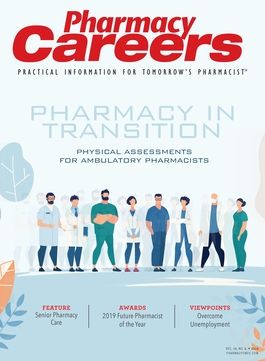Publication
Article
Pharmacy Careers
Interprofessional Education Programs Focus on Pharmacists as Patient Care Providers
Author(s):
As pharmacy practice evolves and the role of pharmacists continues to expand, the notion of working alongside other health care professionals to provide patient services is becoming more widely accepted as key to a pharmacist’s job.
As pharmacy practice evolves and the role of pharmacists continues to expand, the notion of working alongside other health care professionals to provide patient services is becoming more widely accepted as key to a pharmacist’s job. Pharmacy students are on the forefront of interprofessional collaboration, as they learn to recognize the value in partnering with nonpharmacy disciplines as part of their education.
The Massachusetts College of Pharmacy and Health Sciences (MCPHS) in Worchester, and Washington State University College of Pharmacy and Pharmaceutical Sciences (WSUCP) in Spokane are 2 schools offering interprofessional education (IPE) programs to prepare student pharmacists for their future roles as patient care providers. Programs at these schools were presented at the 2019 annual meeting of the American Association of Colleges of Pharmacy (AACP) in Chicago.1,2
At MCPHS, the IPE program brought together pharmacy and optometry students with a goal of improving each group’s knowledge in providing optimal eye care to patients. The program included hands-on activities focusing on nonprescription ophthalmic products and self-treatable ophthalmic conditions, such as dry eye and allergic conjunctivitis.1
The program consisted of third-year pharmacy students and fourth-year optometry students presenting information to each other, according to Kaelen C. Dunican, PharmD, MCPHS Professor of Pharmacy Practice. Students also examined over the-counter (OTC) ophthalmic products and discussed clinical implications of those medications with faculty and peers.1
Stephanie Conway, PharmD, associate professor of pharmacy practice at MCPHS, said the IPE provided pharmacy students with a deeper education in ophthalmic conditions and treatments than what is typically offered by pharmacy schools.1
“Aside from what they see on their clinical rotations or products that they’d see on a patient’s medical record, ophthalmic products are not something that pharmacy students are super familiar with,” Conway said during her presentation with Dunican.1
Through the IPE activities, pharmacy and optometry students discussed similarities and differences among OTC products and which were most beneficial to patients, based on symptoms presented and ocular findings.1
In addition to optometry, opportunities to collaborate extend to physical therapy, nursing, physician assistance, acupuncture, diagnostic medical sonography, and dental hygiene, as well as other disciplines offered by the university, Dunican said.1
WSUCP implemented a new approach to interprofessional education with the creation of a pharmacy compounding club made effective during the 2018-2019 academic year. The program is a partnership between the pharmacy school and a medical dermatology club at Pacific Northwest University of Health Sciences.2
The club also operates with a student-teach-student model, but this one is set in a compounding laboratory, according to the authors of a poster presented at the AACP meeting. Its goal is to implement a recurring, interactive IPE session for pharmacy students and osteopathic medicine students, and to establish the norms of collaborative health care teams for students before they enter the professional field.3
In the WSUCP program, each IPE session was a 2-hour interactive segment offered once a semester. About 25 to 30 students participated in each session. Faculty facilitated the program and advised students as they developed and delivered most of the content.3
Each discipline delivered a presentation and led an activity to illustrate their respective roles in patient care. The sessions involved 6 steps: planning, topic selection, content development, medical student presentations, pharmacy student presentations, and student reflections.3
The impact of the IPE programs at both pharmacy schools was analyzed to gauge effectiveness and student satisfaction.1,2
The pharmacy-optometry program at MCPHS relied on preand postprogram surveys. According to faculty, surveys showed that most pharmacy students who completed the course had an expanded knowledge of ophthalmic conditions and treatments, as well as increased confidence in their abilities to provide patient services for eye care.
“The optometry students learned a lot; the pharmacy students learned a lot. I learned a lot from working with optometrists,” Dunican said at the AACP meeting.1 “The reward for the students was pretty great. I think everyone benefited from this activity.”
For the IPE program at WSUCP, the AACP poster authors found that although content presented by osteopathic medicine students had largely been covered in the pharmacy curriculum, pharmacy students gained experience in delivering educational material by taking on additional teaching responsibilities.3
The poster authors also found that the student-teach-student model of learning has many benefits, ranging from increased confidence to leadership development.2,3
REFERENCES
- Conway S. Dunican K. I-P-E for the E-Y-E: PharmD and Optometry Students Collaborate to Improve Nonprescription Ophthalmic Product Knowledge: presented at: 2019 Annual Meeting of the American Association of Colleges of Pharmacy; July 13-17, 2019: Chicago, IL.
- Darst E, Brand-Eubanks D, Scott M. A Novel IPE Collaboration Between a Pharmacy Compounding Club and a Medical Dermatology Club: presented at: 2019 Annual Meeting of the American Association of Colleges of Pharmacy; July 13-17, 2019: Chicago, IL.
- Antrim A. Universities Practice New Approach to Interprofessional Education. Pharmacy Times website. https://www.pharmacytimes.com/conferences/aacp-2019/universities-practice-new-approach-to-interprofessional-education. Published July 17, 2019. Accessed September 19, 2019.







